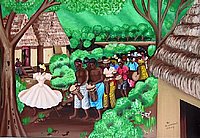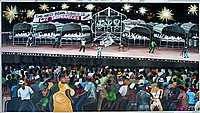|
www.PanOnTheNet.com |
|
|
About The Artist: Joseph Aldwin Charles
With no further secondary or formal schooling, Charles became a self-taught Welder and an Auto Body Repair Technician. In 1974 he moved north to Trinidad's capital, Port-of-Spain, with the aim of developing his already considerable talents, becoming an accomplished artist and earning his livelihood.
The beauty of artist Joseph Charles' work also looms large for all to see on the hills of Laventille. The largest-ever murals in Trinidad and Tobago (55 feet high) of the twin-island republic's national birds, the Cocorico and Scarlet Ibis - are featured on the large water tanks on the hill. Laventille is the home of one of Trinidad's legendary Steel Orchestras, Desperadoes. Charles also channels his energies into the calypso art form part-time, under the sobriquet “Research.” Additionally, he has a proven track record as a selfless and dedicated community leader who devotes a lot of time to the development of the youths in the Laventille area in the field of art, culture and sport. Many people continue to benefit from Charles' teachings free of charge.
A Word from The Collection's Author and co-creator, Dennis Fakoory Dennis Fakoory always had an appreciation for Exodus Steel Orchestra, but admits that his interest in pan was really cemented during the development of the Joseph Charles' art collection. What changed, Fakoory says, is that "my recent understanding of the pan's developmental process, the historical path the pan has traveled to get to be the accepted musical instrument it is worldwide today, and the three years that I have journeyed with the artist in this production. I also love history because it puts life to everything and gives true meaning to us as a people. It tells the whole story as to why we are who we are and why we think the way we do. It also most importantly, gives us the opportunity through that understanding to be able to change the things that do need changing in accessing and accepting that understanding." "I became interested in this project because I recognized that there was a wonderful story to be told and that it would turn out to be a good investment. During its development I began to recognize that history needed to be preserved and I had utmost faith in an unknown artist Joseph Charles, that he could incorporate his vision and my ideas to produce a most valuable collection." "The response so far has been amazing by the men and women in the street. They get lost in the pieces and spend hours just reminiscing and reliving their moment in time. Their opinion to me is most important because it is their lives and their story that we have told, and they have embraced it." Fakoory is seeking a buyer for this collection who will make it available to the pan lovers the world over, if not 365 days a year but at least have annual exhibitions. "What I would not like is for it to end up in someone's home locked away for the eyes of only a few to admire. It would also be beneficial to have as many people as possible learn of the Steelpan's history and its development." If this does not materialize, during the scheduled exhibition in the last week of August 2005, the Joseph Charles art collection is slated for sale by private auction. "During our initial exhibition held at The National Museum and Art Gallery [in Trinidad] in February and March of 2003, we received great reviews from international visitors visiting Trinidad and Tobago for Carnival from England, Japan, North America and Switzerland. A number of them returned the following year hoping to see these paintings again at the museum." "The government
of Trinidad and Tobago have expressed their desire to acquire this
collection and while we have not ruled them out we cannot wait on them
indefinitely." Fakoory continued: "the
artist Joseph Charles needs to be properly compensated whereby providing
him with a better quality of life than he has at present." |
©2005
A
WHEN STEEL TALKS
- EXCLUSIVE
ALL RIGHTS RESERVED


 Joseph
Aldwin Charles (left) was born January 1948 in Penal, San Francique, Trinidad.
When his family
moved to Toco, he completed his primary education at Cumana Toco Seven-Day Adventist Primary School.
It was here that he gained an appreciation of what would become his passion
- art. Because of his talent shown, this very young budding artist was selected by the
school's principal to do a special workshop designed for the art
teachers of all the schools in that region.
Joseph
Aldwin Charles (left) was born January 1948 in Penal, San Francique, Trinidad.
When his family
moved to Toco, he completed his primary education at Cumana Toco Seven-Day Adventist Primary School.
It was here that he gained an appreciation of what would become his passion
- art. Because of his talent shown, this very young budding artist was selected by the
school's principal to do a special workshop designed for the art
teachers of all the schools in that region.  When
opportunities in art did not materialize immediately, Charles relied on his
skills as an auto repair technician until 1980. He remained in this
field until 2000, when he undertook the challenge of starting his own business in the sign
painting industry - whereby he could at least continue working in an area
relative to what he really loved - art - albeit not in the manner that he
truly desired.
When
opportunities in art did not materialize immediately, Charles relied on his
skills as an auto repair technician until 1980. He remained in this
field until 2000, when he undertook the challenge of starting his own business in the sign
painting industry - whereby he could at least continue working in an area
relative to what he really loved - art - albeit not in the manner that he
truly desired. In 2000
Joseph Charles joined forces with his patron,
In 2000
Joseph Charles joined forces with his patron,  The
artist's background relative to the steelband industry is a dual one of both observer and
reveler. He chronicles the story of the development of the steelpan, how and why
it originated and the unspoken reasons for its development, from slavery
drums to now (with official recognition as a musical instrument).
Joseph Charles has succeeded in transporting viewers of his works through
the ages, taking them on a journey where they become one with the subject
matter. His paintings are like snapshots of the past where viewers can
literally relive the steelpan instrument's past, simultaneously experiencing
the spirituality of the burgeoning steelpan phenomenon.
The
artist's background relative to the steelband industry is a dual one of both observer and
reveler. He chronicles the story of the development of the steelpan, how and why
it originated and the unspoken reasons for its development, from slavery
drums to now (with official recognition as a musical instrument).
Joseph Charles has succeeded in transporting viewers of his works through
the ages, taking them on a journey where they become one with the subject
matter. His paintings are like snapshots of the past where viewers can
literally relive the steelpan instrument's past, simultaneously experiencing
the spirituality of the burgeoning steelpan phenomenon.  The
artistry of Joseph Charles depicts, and is a fitting tribute to, the
development of the only musical instrument to be invented in the 21st
century, the Steelpan. His paintings facilitate the crucial connection
between the historical culture and humble beginnings of the instrument, and
its metamorphosis into what is today the awesome musical powerhouses known
as full steel orchestras, sometimes one hundred and twenty pan
players-strong.
The
artistry of Joseph Charles depicts, and is a fitting tribute to, the
development of the only musical instrument to be invented in the 21st
century, the Steelpan. His paintings facilitate the crucial connection
between the historical culture and humble beginnings of the instrument, and
its metamorphosis into what is today the awesome musical powerhouses known
as full steel orchestras, sometimes one hundred and twenty pan
players-strong.